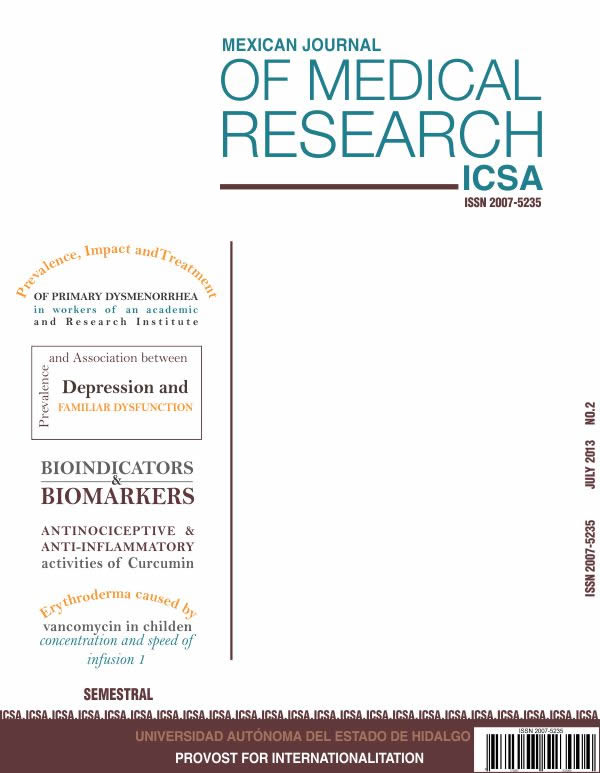Erythroderma caused by vancomycin in children: concentration and speed of infusion
Abstract
Vancomycin is an antibiotic glycopeptide that was isolated of the Streptomyces orientalis. It was introduced in the clinical practice for treatment of infections caused by staphylococcus in which other antibiotics were proving to be ineffective. In this retrospective study, we determine its prescription, clinical characteristics as well as the factors that favor the apparition of the erythroderma or red-man syndrome in a paediatric hospital. Forty patients to which physicians administer vancomycin and presented erythroderma were evaluated. Male gender was more predominated, with a total of 25 cases (62.5 %). The average age was of 12 ± 6 years. We identified two main factors that are directly related to the appearance of erythroderma. On one hand, the "concentration of the drug", which is related to the dilution that it is realized when a dose of vancomycin is going to be administered to the patient and on the other hand the “time or speed of infusion”. In the present study, it was found a low incident of this adverse reaction and few cases of complications.
Downloads
References
2 Lori WaznyD, Behnam D. Desensitization protocols for vancomycin hypersensitivity. Ann Pharmacother. 2001; 35: 1458–1464.
3 Davis RL, Smith AL, Koup JR. The 'red man's syndrome' and slow infusion of vancomycin [letter]. Ann Intern Med. 1986; 104: 285–286.
4 Renz CL, Thurn JD, Finn HA, Lynch JP, Moss J. Clinical investigations: antihistamine prophylaxis permits rapid vancomycin infusion. Crit Care Med. 1999; 27: 1732–1737.
5 Korman T, Turnidge J, Grayson M. Risk factors for cutaneous reactions associated with intravenous vancomycin. J Antimicrob Chemother. 1997; 39: 371–381.
6 Bergeron L, Boucher F. Possible red-man syndrome associated with systemic absorption of oral vancomycin in a child with normal renal function. Ann Pharmacother. 1994; 28: 581–584.
7 Wallace M, Mascola J, Oldfiels E., Ill Red-man syndrome: Incidence, etiology, and prophylaxis. J Infect Dis. 1991; 164: 1180–1185.
8 Polk RE, Healy DP, Schwartz LB, Rock DT, Garson ML, Roller K. Vancomycin and the red-man syndrome: pharmacodynamics of histamine release. J Infect Dis. 1988; 157: 502–507.
9 Healy DP, Sahai JV, Fuller SH, Polk RE. Vancomycin-induced histamine release and 'red man syndrome": comparison of 1- and 2-hour infusions. Antimicrob Agents Chemother. 1990; 34: 550–554.
10 Levy M, Koren G, Dupuis L, Read SE. Vancomycin-induced red man syndrome. Pediatrics. 1990; 86: 572-80.
11 Schaad UB, McCracken GH Jr, Nelson JD. Clinical pharmacology and efficacy of vancomycin in pediatric patients. J Pediatr. 1980; 96: 119-26.
12 Miller R, Tausk HC. Anaphylactoid reaction to vancomycin during anaesthesia: a case report. Anest Analg. 1977; 56: 870–872.
13 Southorn PA, Plevak DJ, Wright AJ, Wilson WR. Adverse effects of vancomycin administered in the perioperative period. Mayo Clin Proc. 1986; 61: 721–724.
14 Massimo B, Flavio B, Roberta C, Carlo C, Francesco G. Pruritus: a useful sign for predicting the haemodynamic changes that occur following administration of vancomycin. Crit Care. 2002; 6: 234–239.
15 Gutiérrez S, Repetto M; “Episodios adversos a medicamentos, detectados en dos servicios de internación pediátrica del Centro Hospitalario Pereira Rossell”. Arch Pediatr Urug 2004; 75: 307-315.
16 Marik PE, Ferris N. Delayed hypersensitivity reaction to vancomycin. Pharmacotherapy 1997; 17: 1341-4.
17 Wazny LD, Daghigh B. Desensitization protocols for vancomycin hypersensitivity. Ann Pharmacother 2001; 35: 1458-64.
18 O’Sullivan TL, Ruffing MJ, Lamp KC, Warbasse LH, Rybak MJ. Prospective evaluation of red man syndrome in patients receiving vancomycin. J Infect Dis 1993; 168: 773-6.
19 Lognon P, Dabout C, Laugier J, Santini JJ. Anaphylactic shock caused by vancomycin. Presse Med 1987; 16: 682.
20 Sorensen SJ, Wise SL, al-Tawfiq JA, Robb JL, Cushing HE. Successful vancomycin desensitization in a patient with endstage renal disease and anaphylactic shock to vancomycin. Ann Pharmacother 1998; 32: 1020-3.
21 Chopra N, Oppenheimer J, Derimanov GS, Fine PL. Vancomycin anaphylaxis and successful desensitization in a patient with end stage renal disease on hemodialysis by maintaining steady antibiotic levels. Ann Allergy Asthma Immunol 2000; 84: 633-5.
22 Kitazawa T, Ota Y, Kada N, Morisawa Y, Yoshida A, Koike K, et al. Successful vancomycin desensitization with a combination of rapid and slow infusion methods. Inter Med 2006; 5: 317-21.
23 Wessel F. Peri-anesthesia allergies to antibiotics. Allerg Immunol (Paris) 1998; 30: 190-2.
24 Villavicencio AT, Hey LA, Patel D, Bressler P. Acute cardiac and pulmonary arrest after infusion of vancomycin with subsequent desensitization. J Allergy Clin Immunol 1997; 100: 853-4.
25 Renz CL, Thurn JD, Finn HA, Lynch JP, Moss J. Oral antihistamines reduce the side effects from rapid vancomycin infusion. Anesth Analg 1998; 87: 681-5.
26 Sahai J, Healy DP, Garris R, Berry A, Polk RE. Influence of antihistamine pretreatment on vancomycin-induced red-man syndrome. J Infect Dis 1989; 160: 876-81.
27 Lieberman P. The use of antihistamines in the prevention and treatment of anaphylaxis and anaphylactoid reactions. J Allergy Clin Immunol 1990; 86: 684-6.
28 Wong JT, Ripple RE, MacLean JA, Marks DR, Bloch KJ. Vancomycin hypersensitivity: synergism with narcotics and “desensitization” by a rapid continuous intravenous protocol. J Allergy Clin Immunol 1994; 94: 189-94.
29 Kwon HS, Chang YS, Jeong YY, Lee SM, Song WJ, Kim HB, et al. A case of hypersensitivity syndrome to both vancomycin and teicoplanin. J Korean Med Sci 2006; 21: 1108-10.













